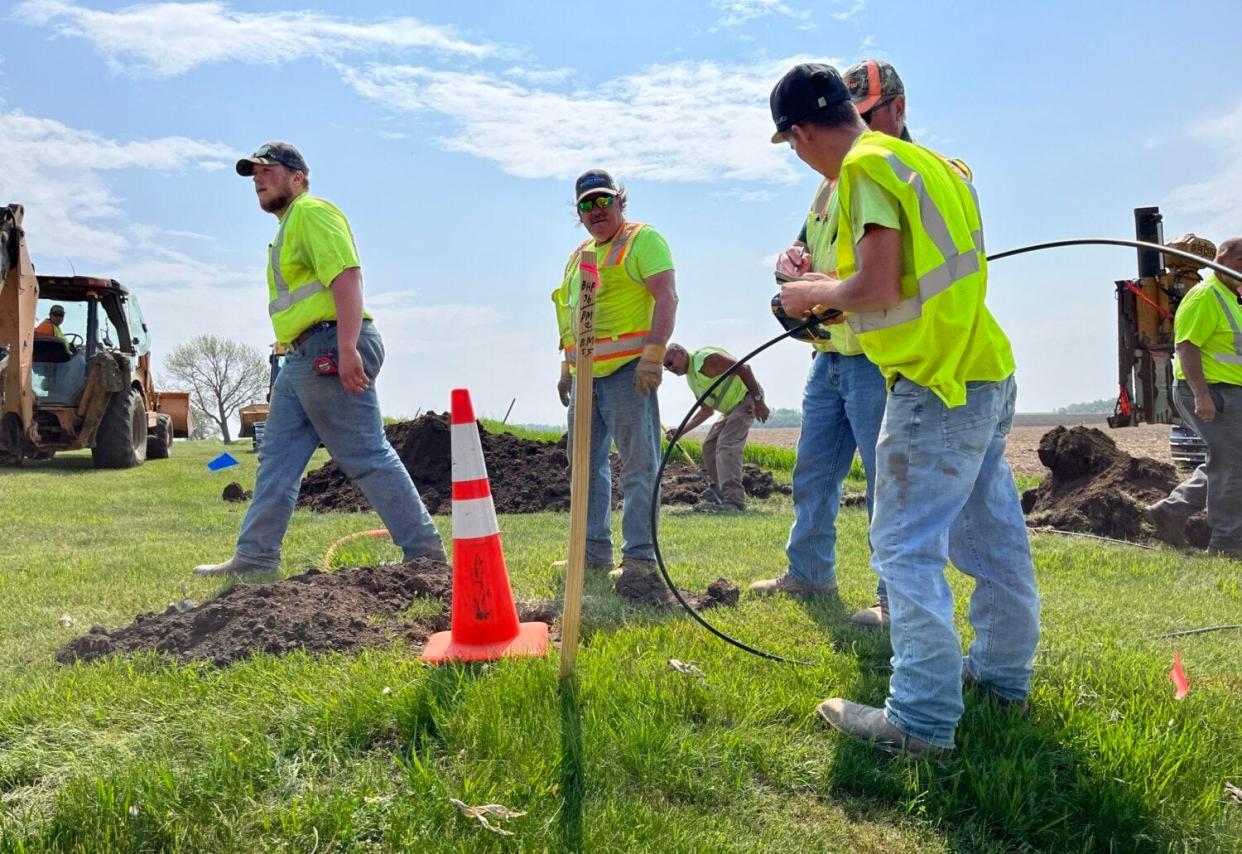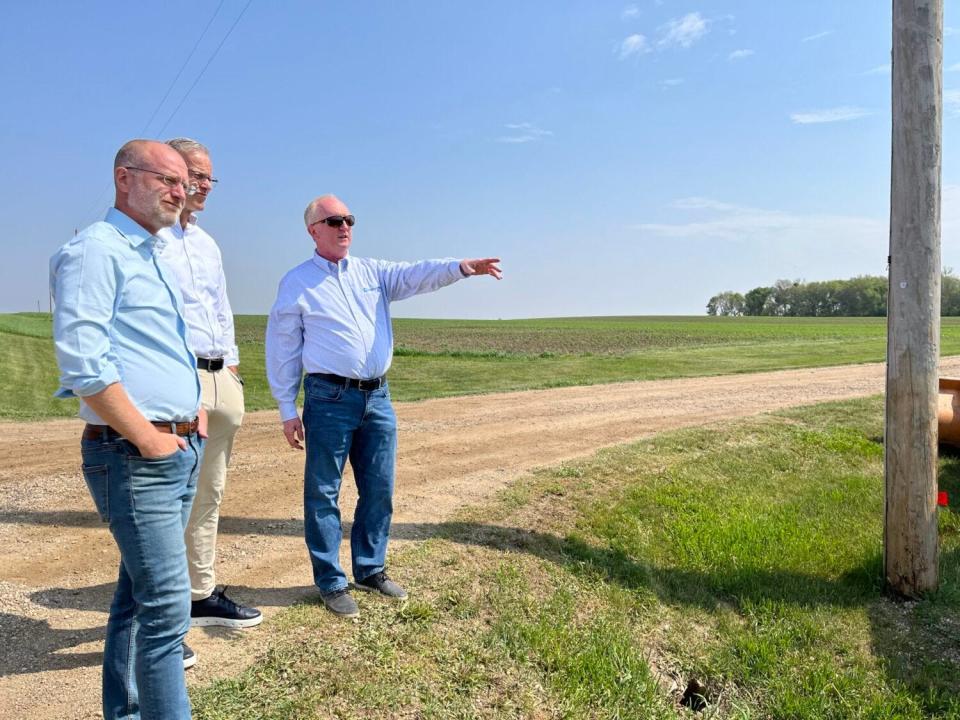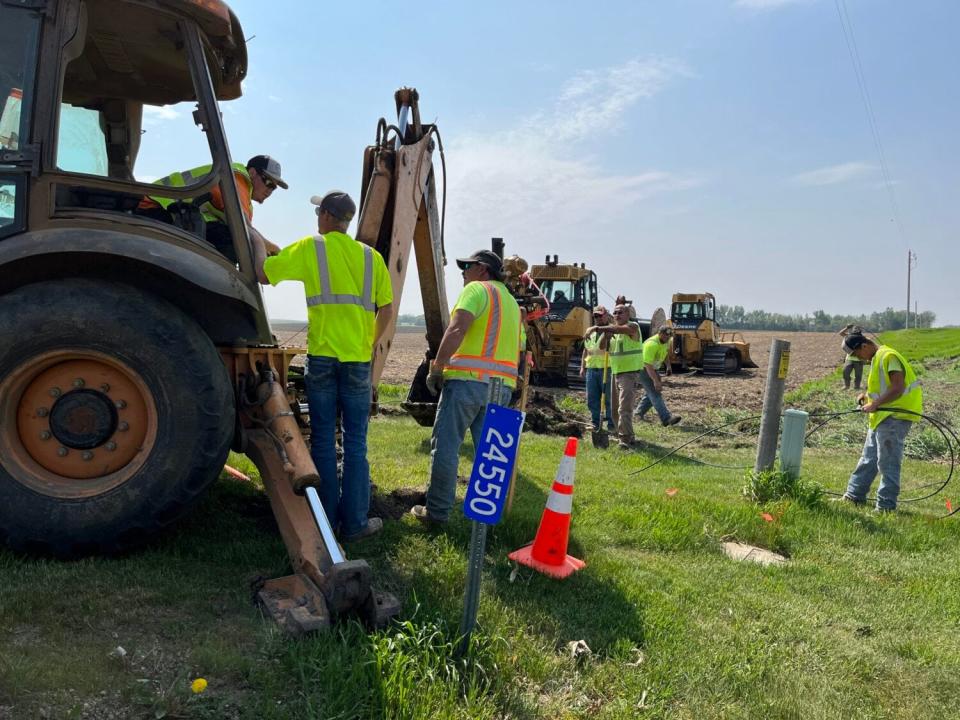Inflation drives up cost of broadband internet projects in South Dakota

- Oops!Something went wrong.Please try again later.
- Oops!Something went wrong.Please try again later.
COLTON — Inflation has taken a toll on ambitious state and national plans for expanding access to high-speed internet service, causing funding for the projects to lose purchasing power.
And while proponents say it’s time to double down on support for the projects, a state representative sees it as an opportunity to rein in the spending.
At a project site near Colton, Golden West Telecommunications CEO Denny Law said the price of fiber-optic cable has gone up 15-50% since 2018. He said higher fuel prices and rising wages are also taking a toll.
“All of those things flow through to increase the price of the broadband deployment,” Law said.
Mike Young is the chief operating officer of South Dakota-based ANCO Underground, a contractor that installs utility infrastructure. Young said pandemic-related supply chain issues have resulted in six- to eight-month backorders on new equipment.
“Which makes it difficult for a contractor to forecast around,” Young said.
And in some instances, the cost of that equipment “is going up by about 4% a quarter – that’s 16% in a year,” Young said. “If inflation doesn’t slow down, it will continue to have an impact on our bottom line.”
Young said that’s all having an impact on the company’s ability to bring broadband to places like the Black Hills, where cutting through rock to bury fiber-optic cable is an already expensive endeavor, requiring help from state and federal government funding.

“These subsidies can offset that to help close the digital divide out there,” Young said.
Law said Golden West Telecommunications is deciding whether to moderate the size and scope of projects. He’s optimistic that Congress and the Federal Communications Commission will refill broadband funding pools. Law said these projects could not happen without subsidies, and D.C. delivering “will allow companies like Golden West to continue with this for years ahead.”
Federal Communications Commissioner Brendan Carr and U.S. Sen. John Thune, R-South Dakota, joined Law at the Colton job site recently.
“We have a unique opportunity to truly end the digital divide,” Carr told South Dakota Searchlight. “We have the support available from D.C. to do that. The real challenge, now, is making sure we have the right policies in place.”
In the wake of the COVID-19 pandemic – and record stimulus spending by governments in response – a rising tide of inflation has engulfed nations worldwide. The pandemic also highlighted the value of high-speed internet connections, as the world increasingly relied on digital platforms for work, education and health care.
While the definition of “high-speed internet” has changed over time, it generally refers to an internet connection that provides faster data transfer rates compared to traditional dial-up connections. “Broadband” is a term often used interchangeably with high-speed internet. It refers to a type of internet connection that has a wide bandwidth, enabling the transition of multiple data streams.
Thune is the ranking member of the Senate Subcommittee on Communications, Media and Broadband. Despite rising costs, he remains committed to broadband expansion given the benefits.
“Whether it’s distance learning, telemedicine or precision agriculture,” Thune said. “And it’s becoming easier for people to work and live here. Even if they have a job someplace else, if you have high-speed internet services, the sky is the limit as to what you can do.”

Questioning subsidies
Not every South Dakota Republican politician is excited about the additional spending.
Rep. Chris Karr, R-Sioux Falls, questions if providing high-speed internet access is the role of government.
“The federal government has already been spending billions and billions of dollars on this,” Karr said. “Is it the role of government to cut through a mountain to deliver internet? I question that. Because, if you move somewhere remote, there are going to be trade-offs.”
Citing mounting concerns over inflation and the federal budget deficit, Karr argues government’s involvement in broadband expansion is an overstep that should be curtailed.
“We talk about a debt ceiling and the question is always, ‘What are you gonna cut?’” Karr said. “This is one of these areas where we should take a look.”
Karr argues that market forces and private-sector initiatives can drive broadband expansion, pointing to industry-led projects like high-altitude balloons that beam down wireless internet.
“We are stifling innovation; because, when we hand out cash, it’s those that are not innovative that are first to the trough,” Karr said. “If inflation has increased the cost, these private companies benefiting from this should pony up that difference.”
Proponents of government-subsidized broadband expansion say it has measurable benefits. According to a 2020 Federal Reserve report, a 10 percentage point increase in broadband access in 25 developed countries resulted in a 0.9 to 1.5 percentage point increase in annual per capita growth. Additionally, consumers benefited from access to a wider array of goods and services, leading to cost savings estimated at $1,850 per household annually. And homeowners experienced higher property values.
According to the Governor’s Office of Economic Development, $221.3 million was spent on 90 broadband expansion projects in South Dakota from 2019 to 2022. That includes $86.3 million of federal funds, $28 million of state funds, and $107 million of private funds, giving high-speed internet access to 27,500 locations.
In May, the governor’s office announced another $32.5 million would go toward 13 more projects, connecting 3,137 more locations. The Governor’s Office of Economic Development did not respond to South Dakota Searchlight questions for this story.
According to BroadbandNow, 88% of South Dakotans have access to 100 megabit-per-second internet service, ranking 35th among all states in that statistic.
This article originally appeared on Sioux Falls Argus Leader: Inflation drives up cost of broadband internet projects

